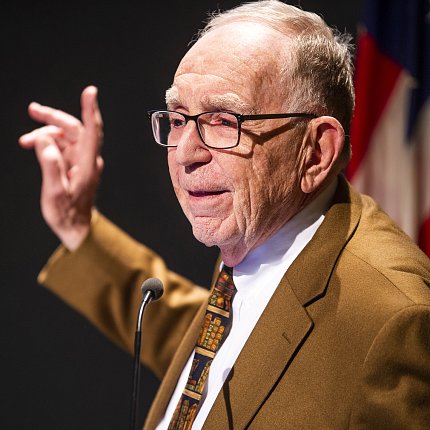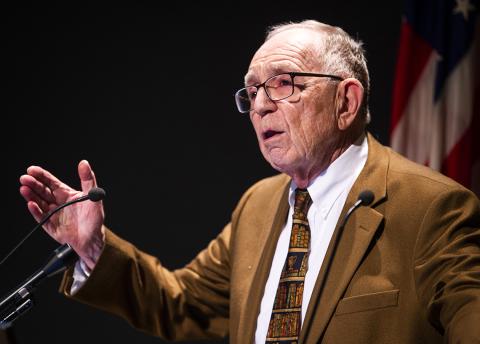‘AI Centaurs?’
Feigenbaum Searches for Signs of Computer Creativity

Photo: Lisa Helfert
As a child, Dr. Edward Feigenbaum had watched his father, an accountant, feverishly tapping the buttons on his calculator to do his math. The idea that machines could speedily replicate human computations fascinated the younger Feigenbaum. In college at Carnegie Tech (later Carnegie Mellon University), under the mentorship of future Nobel laureate Herbert Simon, he became deeply interested in the software that models human intelligence, perception and discovery, what is now called “AI,” or artificial intelligence.
That interest guided the career of Feigenbaum, a renowned AI scientist and computer science professor emeritus at Stanford University. He spoke to a packed Lister Hill Auditorium recently at the annual Donald A.B. Lindberg and Donald West King Lecture in Medical Informatics and/or Pathobiology, co-sponsored by NLM.
Feigenbaum and Dr. Joshua Lederberg led a research team that developed the first expert systems in artificial intelligence nearly 55 years ago. Considered the second wave of AI, these computer programs used encoded knowledge from human experts in specialized fields to help solve complex problems, including medical diagnosis and therapy. For example, an early expert system, done by a student in Feigenbaum’s lab, helped doctors diagnose blood and meningitis infections.
The famous codebreaker and “father of computer science” Alan Turing maintained that computers should be regarded as intelligent if their thinking behavior was indistinguishable from that of people, said Feigenbaum, a Turing Award laureate. But do computers simply churn out programmed information or do they have the capacity to be creative?
“A creative act, for me, means these three things,” said Feigenbaum. “It’s extremely surprising to those [who are] expert in the field; it’s novel, maybe even so novel that it’s new to mankind; and it evokes awe in the community of specialists in [that] area.”
By this definition, computer creativity began to emerge even in the earliest AI programs. In the second wave of AI, some “deep search” AI programs were written. They had weaker knowledge than expert systems but could search far more deeply for novel solutions.
Take the game of chess, with 10120 possible paths to win, lose or draw. For such astronomical computations, said Feigenbaum, we need heuristics. These knowledge-based methods help us prune searches to reasonable levels that can be accomplished in timeframes relevant to humans.
For a creative behavior, “You’re not looking just for a needle in a gigantic haystack,” he said. “You’re looking for a golden one in that gigantic search space.”

Photo: Lisa Helfert
In 1997, the IBM Deep Blue computer and software found the golden needle to beat world champion chess grandmaster Garry Kasparov. A human champ might not have a computer’s vast search capacity, but does have superb expert pattern recognition and knowledge of chess that minimizes search. By contrast, Deep Blue searched deeply, though it didn’t search nearly the total number of possible paths. Deep Blue won what was a close match by making a brilliant move. The move inspired awe, astounding chess experts. Even Kasparov had noted creativity in the computer’s moves.
Deep search also proved victorious in a game with a much larger search space than chess. The ancient Chinese game of Go has an almost unfathomable 10800 winning paths. Yet a program called AlphaGo, developed by AI scientists at the Google-owned DeepMind, eventually beat two human Go champs in 2015.
Again, the computer could not possibly search all potential winning paths, but it still won. One European champ exclaimed he’d never seen such play. It was creative, said Feigenbaum, in that it was a novel, awe-inspiring demonstration of skill.
It’s as if the computer says, “I don’t have to search to the bottom of the search space,” said Feigenbaum. “I just have to search deeper than you and I will find that golden needle in the haystack that you couldn’t find, because you’re human and can’t systematically enumerate and search all those possibilities, even given the heuristic knowledge you have.”
AI may, in fact, be headed toward greater cooperative intelligence, said Feigenbaum, who envisions many creative acts in medicine and other areas stemming from human-computer teams, sometimes called “AI centaurs.”
“Working collaboratively, they’ll produce a result that’s better than either of them could do by themselves,” he said.

Photo: Lisa Helfert
Feigenbaum recounted an early example of AI centaurs that took place 35 years ago. A Stanford computer science professor, Dr. Douglas Lenat, collaborated with EURISKO, an AI program he’d created, to find an unbeatable move in the war game Trillion Credit Squadron.
EURISKO would run all night, said Feigenbaum. Each morning, Lenat would pick a few “best” moves. EURISKO continued searching; Lenat continued evaluating and pruning the searches daily, for months. Together, Lenat and EURISKO found an unexpected winning move in the huge game search space that he took to the world championship, and won.
But most people don’t think of game-winning moves when they think of creativity. Often, creativity conjures up images of art or music. So Feigenbaum shared another early example of an AI centaur in the art world.
British abstract artist Harold Cohen had aspired to capture his art in an expert system. Cohen, who spent 2 years at Stanford’s AI lab in the 1970s, wrote out rules based on the many artistic elements that went into his artwork and how each related to what came next to complete each image. From 1973 to 2016, Cohen wrote the computer program AARON, which generated new images based on Cohen’s thousands of rules that he believed captured his artistic skills.
“This is a human-computer interaction between Harold Cohen and what he knows about his art. AARON generates images in this enormous space,” said Feigenbaum, who considers this computer-generated art unequivocally creative. AARON’s images are still being shown at art galleries and museum exhibits internationally.
As computers become even more powerful, and as data grows more voluminous and complex, it will be fascinating to see what yet-unimagined capabilities future waves of artificial intelligence will bring.
Said Feigenbaum, “Using enormous combinatorial or textual searches…with an expert human partner, systems of collaborative intelligence will find superb creative acts that mankind unassisted did not, or could not, think of.”
